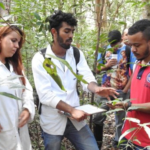
Lies Sercu
The need to educate teachers through a mix of traditional content-based and newer competence-based teaching and assessment methods has been recognized for quite some time now. The idea of competences was introduced because of a disconnection between what was taught in academic courses and what was needed in the profession. Teachers who only possess subject-specific knowledge but do not know how to build on that knowledge to design meaningful learning tasks and environments that can support their students’ learning will not be successful in their teaching.At the same time, a tendency has become noticeable away from a lecturer-centered curriculum to a model of education that centers more on self-regulated learning (SRL) and allows teacher trainees to (co-)determine their own learning goals according to personal needs. This process, involving developments in teacher beliefs, reflective and motivational self-regulative abilities and educational reasoning skill, is co-guided by internal and external feedback mechanisms on task-performance. In teacher education, external feedback may come from the students being taught, supervising school mentors and university practice lecturers.
In the past, summative evaluation of learning achieved in practice-based self-regulated learning environments by university lecturers was done based on written product-oriented documentation portfolios. Teacher trainees were expected to document their learning trajectory by means of lesson preparation plans and reflective documents in which they reviewed their actual teaching performance in the classroom, determined learning points and indicated how they intended to eliminate any remaining shortcomings, with few, if any, opportunities for process assessment, lecturer feedback or formative evaluation.
Thanks to technological developments, the often hefty and massive paper documentation binders handed in at the end of school internships can now be replaced by e-portfolios which allow for a closer monitoring of the learning trajectory with more frequent possibilities for remedy when progress is insufficient, or chances are that the attainment targets set for school internships will not be achieved without an appropriate intervention.
This paper describes the e-portfolio that is currently in use at Leuven University’s language teacher training program. The portfolio has been developed over the past four years in a joint effort by teacher training staff and the KU Leuven ICT for Education “Toledo” development team. Toledo is the name given to the KU Leuven secured and integrated IT platform for education-related assessment, evaluation and learning activities. The conceptual framework on which the portfolio builds will be elaborated first, after which the portfolio itself will be presented.
A conceptual framework for supporting professional growth in pre-service teachers
Self-regulated competence-based learning requires the identification of the professional competencies and attitudes that need to be acquired, the specific tasks that are to be performed, what is to be learned from task execution and how interim and end achievement of the preset attainment targets will be assessed. Together, these components, elaborated in the next paragraphs, constitute the pillars of the pedagogical approach embedded in our eportfolio.
Competency framework for pre-service teachers
In 2007, the Flemish government proposed a revised version of the competencies and attitudes framework first decreed in 1998, now taking account of new priorities in educational policy, with more emphasis being placed on the development of ICT skills in teachers, their ability to support second language learning in all subjects, and the acquisition of competencies enabling teachers to better meet the specific needs of culturally diverse students.
As can be seen from Table 1, ten areas of competence, related to three specific responsibility domains are put forward, as are ten attitudes that need to find concrete application with respect to any of the ten functional components of beginning teachers’ professional competence.
| 10 functional components | 10 attitudes |
|---|---|
| Responsibility for the learner | |
| 1. The teacher as a guide of learning and development processes | 1. Decisiveness |
| 2. The teachers as educator | 2. Relational orientation |
| 3. The teacher as subject expert | 3. Critical reflection |
| 4. The teacher as organizer | 4. Eagerness to learn |
| 5. The teacher as innovator | 5. Organizational skills |
| Responsibility for the school and educational community | |
| 6. The teacher as partner of parents and care-takers | 6. Sense of collaboration |
| 7. The teacher as member of a teaching team | 7. Sense of responsibility |
| 8. The teacher as partner of external parties | 8. Creative orientation |
| 9. The teacher as member of the educational community | 9. Flexibility |
| Responsibility for society | |
| 10. The teacher as culture participant | 10. Orientation towards a correct and appropriate use of language and communication |
Each of the functional components and attitudes is further specified in more specific attainment targets, which we will not fully elaborate here but merely illustrate by way of an example. Thus, ‘The teacher as guide of learning and development processes’ is broken down in abilities relating to (1) defining the initial situation and selecting learning goals, (2) designing powerful learning environments, (3) assessment for learning and of learning, (4) meeting cultural diversity and special needs in learning. ‘Decisiveness’, the first attitude mentioned, is then reformulated as ‘the teacher dares take a stand and acts on it in a responsible manner. S/he can provide sensible objective and rational arguments for any choice made’ with respect to any of the sub-abilities (1–4) mentioned in the above example.
Self-regulated learning as a framework for clarifying professional development
SRL is a core conceptual framework to understand the (meta)cognitive, motivational, and emotional aspects of (competence-based) learning. Understanding these features and their interactions can help to design learning environments that appropriately stimulate learners’ self-regulated development in the direction of the attainment targets set. As Hattie et al. (1996, 131) in a meta-analysis of SRL effects state, “it is recommended that training (a) be in context, (b) use tasks within the same domain as the targeted content [i.e., knowledge, attitudes and skills], (c) and promote a high degree of learner activity and metacognitive awareness”. For teacher trainees, in addition, attention will crucially be given to strengthening pedagogical, instructional and educational reasoning skills at the micro, meso and macro levels of education.
Based on an extensive comparative analysis of six models of self-regulated learning (Panadero, 2017), it was decided to conceptualize our teacher training learning environment according to Zimmerman’s Multilevel model (Zimmerman and Kitsantas, 2005) and Winne and Hadwin’s SRL model (Winne & Hadwin, 1998), with the latter focusing specifically on the development of a professional internal self-monitoring and self-control system.
In Winne and Hadwin’s model presented in Figure 1, while preparing for a task, actually performing it and afterwards reflecting on task execution (cf. the cyclical phases models by Pintrich, 2000 and Zimmerman & Moylan, 2009), teacher trainees are viewed as developing a system of pedagogical, instructional and educational reasoning that takes account of task conditions, the learner’s cognitive conditions, self-determined goal-related standards and external feedback and evaluation. Teacher trainees’ learning is seen as an active and pro-active self-directed process of learning to monitor, regulate and evaluate one’s thinking, behavior and motivation, in interaction with others.
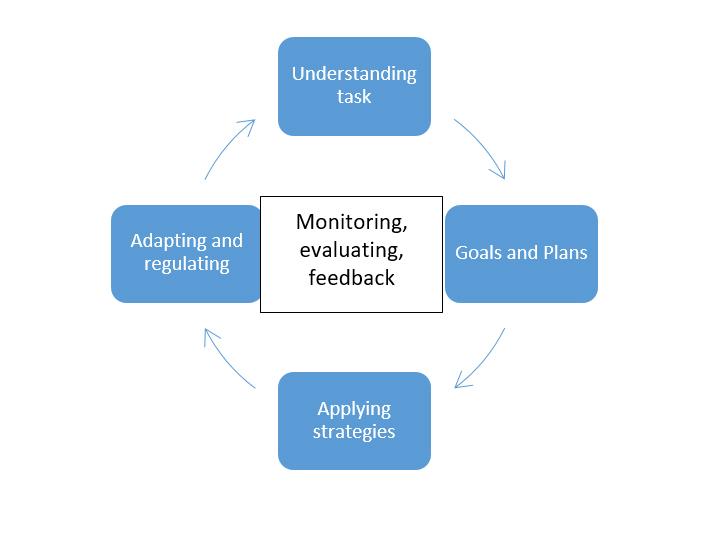
For example, when asked to develop, say, a 15-minute written test for assessing intermediate language students’ mastery of a specific area of a foreign language’s grammar, teacher trainees will need to fuse and integrate the relevant information on language tests processed during preparatory courses, their current assessment of the requirements of the specific task, the time allotted for the test, the way in which the grammar point in focus was taught, and the social context in which assessment is to take place. In addition, they will need to determine which domain knowledge, task knowledge and knowledge of assessment and test development strategies to integrate, building on appropriate beliefs regarding testing and assessment of students at that level of language proficiency and education. While developing the test they will need to keep themselves motivated and critically self-reflective, demonstrate decisiveness, creativity and a sense of responsibility. All along, and after test administration, trainees will need to monitor task performance on the basis of internally developed standards of excellence while taking account of external feedback. Feedback may come from the students’ taking the test, the students’ performance on the test, feedback from more experienced test developers, such as school mentors, or the university practice lecturer who has studied the full cycle of test development, administration and evaluation on the basis of the information provided by the trainee in the ePortfolio.
When teacher trainees observe, imitate and independently perform the same task repeatedly, as they are asked to do in our teacher education program, maintain their eagerness to learn, and recursively receive appropriate and stimulating external feedback, they will be able to develop more expert skills, moving to the Zimmerman & Kitsantas’ level of self-control and self-regulation. Indeed, in Zimmerman’s Multilevel model (Zimmerman and Kitsantas, 2005), a distinction is made between an (1) observation level, where learners observe more proficient task performers observation, (2) an emulation level, where learners imitate particular competencies with social assistance, (3) a self-control level, where learners independently display particular skills and attitudes under structured conditions, and, finally, (4) a self-regulation level, where learners can use the acquired skill across changing personal and environmental conditions.
Realistic learning tasks in competence-based teaching
The use of realistic tasks is one of the most important features of competence-based learning. The tasks that trainees are to complete should be representative of the tasks of a teacher at the level of education for which they are preparing. These tasks should also have a demonstrable connection with the competencies to be achieved (Wesselink et al. 2010). Typical tasks to be performed by language teachers in secondary education in Flanders include the analysis of curricular documents; day-to-day subject-specific and subject-overarching (ICT-supported) lesson preparation; the critical evaluation of (commercially available) learning materials; assessment of learning and for learning; helping students who lag behind catch up via remedial teaching; innovate and improve one’s own teaching; engage in opportunities for continuous learning; keep up-to-date of professional literature; take up responsibility for team or school-based tasks; communicate with students, parents, colleagues, and external parties.
This catalogue of tasks, which are indeed included in the ePortfolio discussed here (see Figure 3 below), obviously, reflects the competencies and attitudes to be developed by Flemish teachers as put forward in Table 1.
Multiperspectival assessment of competence-based learning
Assessment activities, in the form of face-to-face mentoring meetings or written evaluative feedback, need to make the competence-based learning process transparent for the trainee, at regular intervals identifying gaps between existing skills, behaviors and attitudes and desired competence to be achieved, departing from the list of teaching competencies and attitudes identified in Table 1.
In addition to university practice lecturers, other parties are involved in the teaching and evaluation process. They include the trainees themselves (self-assessment), but also school mentors and other (coordinating) language teachers involved in the trainee’s internship. Mentors, especially, who supervise the trainee’s learning process, will need to understand what competencies need to be attained and how attainment can be supported, stimulated and assessed over the course of a school internship. Their understanding will need to match that of university lecturers’ understanding so that trainees are not confused as to what assessment standards will be used.
In addition, supervising lecturers and mentors must be cognizant of differences in speed of development, take account of that and adjust their feedback and interventions accordingly. Even if stages in teacher development need to be more as a heuristic device in understanding development than as fixed accumulative stages, it is nonetheless observable that beginning trainees are focused on the self, on their own behavior, trying to implement skills, apprehensive of losing control over their class, with little flexibility or autonomous decisiveness demonstrated. In the next stage, the trainee has gained more confidence in his or her skills and is able to implement a larger variety of approaches and techniques. Moreover, it becomes clearer to the trainee how teaching interventions affect learners and the learning process. In the third stage, the trainee has gained a more complex view of the teaching and learning process and of the power he/she has to direct it in ways that promote learning. More mature and sophisticated thinking leads to the identification of personal strengths and weaknesses, and to the identification of actions to be taken to alleviate any remaining shortcomings.
Eportfolio for self-regulated competence-based learning in teacher education
The ePortfolio presented in Figures 2 through 6 has been built on all the learning and assessment principles outlined in Section 2. Given that the portfolio was developed for use at a Dutch-speaking university and is not only used by teacher trainees in languages, but also in other fields of studies, most information provided in the figures is in Dutch, except for the data in Figure 5 which have been entered by a student of English. We have nevertheless wanted to include some screenshots to provide an impression of the look and feel of the very user-friendly learning environment. The figure titles and comments indicate what each screenshot wants to demonstrate.
Figure 2 shows how the Toledo process portfolio differs from the commercially available Blackboard documentation portfolio. The Toledo Portfolio, with a student and lecturer version, is accessible via the secured KU Leuven teaching and learning platform for those to whom access rights have been granted. At the beginning of every academic year, the Toledo development team links each teacher trainee to his/her assigned university lecturers. It is the student who grants school mentors access to relevant internship documents. Every party involved only has access to the documents relevant for the completion of the tasks set for that party. All documents are kept on a central server that is maintained by KU Leuven. Students can download their portfolio for future reference and use. A backup service is in place.
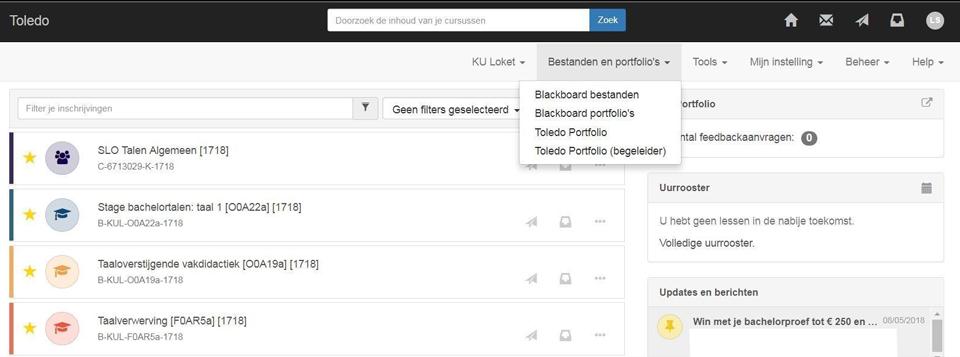
In Figure 3, there is the student homepage, listing tasks to be completed (left side) with due dates (right side). Document upload tools are provided, and task and time management tools help learners to keep good track of their work.
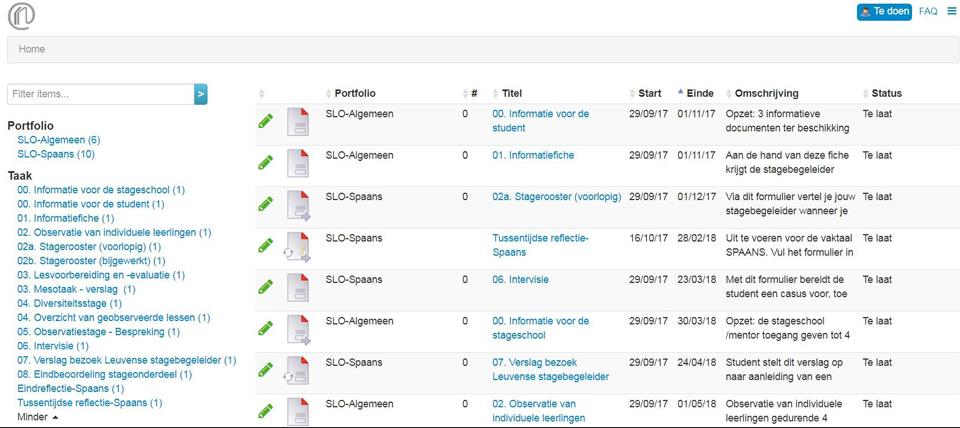
An example of task and workflow description is presented in Figure 4. Precise and explicit description of every task and the workflow to be followed to complete it is essential in self-regulated learning competence-based e-portfolios. Under ‘Workflow’ the following information is provided: ‘1’ tells the student to fill out the competence matrix and explains that the student need not complete the full matrix in one go since the information the student provides now can be saved for later, to be completed and/or updated. ‘2’ explains that the student can find more information about what each level of competence (5 levels distinguished as can be seen from the five orange circle symbols) stands for through clicking on the blue symbol with the white circle. ‘3’ instructs the student to explain why s/he believes a particular level of attainment with respect to a particular competence has indeed been reached, and to indicate what actions will be taken to try and move up to the next attainment level. ‘4’ asks the student to send the completed form to his/her school mentor via the ‘Ask feedback’ button before the set deadline, and informs the student that the mentor will in his/her turn assess the student’s progress.
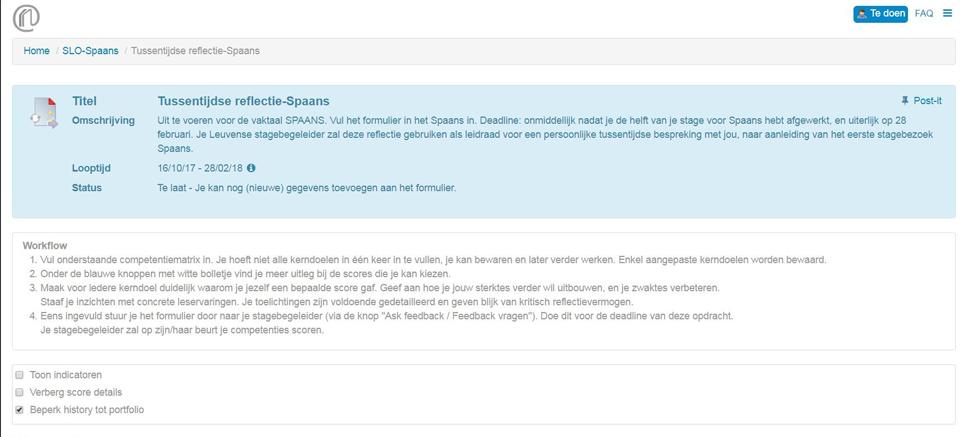
Student self-assessment of the attitude ‘decisiveness’ is the second self-assessment, with first self-assessment done two months earlier (Figure 5). The student demonstrates metacognitive reflective abilities and states to appreciate the feedback she receives from mentors. Yet, she shows evidence of already matured beliefs regarding teaching, stating that every teacher can develop a personal teaching style depending on personal strengths and experience.

An extract from the mentor feedback form, where feedback here concerns the aquadecy of learning goals and learning objectives, is shown in figure 6. Mentors are asked to grade the student using a five-point scale ranging from very inadequate to excellent. An example of feedback provided went as follows (my translation from Dutch): “When teaching at this level, you really need to master what you teach, what is in your course materials, and you need to have extra background knowledge or extra examples ready. Moreover, you need to be able to anticipate particular questions or student answers, to avoid being surprised and then providing students with incorrect or vague information. This is not easy and requires quite some preparation time (especially when you teach at this high a level), but it is crucial for turning your lesson into a success. I want to encourage you to indulge into a more thorough and precise preparation work and then you should be fine and be able to meet all student questions adequately.”

Conclusion
Student portfolios now document trainees’ self-directed development towards the attainment of the competencies and attitudes expected of novice teachers. With the implementation of the e-portfolio, the roles of school mentors and university lecturers have changed. Both have gained the status of supervisors who continuously support and challenge trainees to improve and reach further, linking theory into practice, and communicate progress or lack thereof on a continuous basis.
We are confident that the e-portfolio as it stands now reflects a consistent learning trajectory, with attainment targets, learning tasks, feedback to students, teacher roles and the organization of the curriculum together supporting the development of a future generation of teachers who will be well-equipped to educate their pupils and students towards self-regulated competence-based learning.

This article was produced in the Erasmus+ (KA2 action) funded project “Empowering Eportfolio Process (EEP)”. The beneficiary in the project is Häme University of Applied Sciences (FI) and the partners are VIA University College (DK), Katholieke Universiteit KU Leuven (BE), University College Leuven-Limburg (BE), Polytechnic Institute of Setúbal (PT) and Marino Institute of Education (IE). The project was implementated during 1.9.2016–30.11.2018
Author
Prof. dr. Lies Sercu is a professor at KU Leuven, Faculty of Arts, Teacher Training Center and Linguistics Department. She teaches courses in Language Acquisition and Language Teaching Methodology. More information on her publications, projects and expertise can be found at https://www.kuleuven.be/wieiswie/en/person/00010757.
References
Hattie, J., Biggs, J., & Purdie, N. (1996). Effect of learning skills interventions on student learning: a meta-analysis. Review of Educational Research 66, 99‒136.
Panadero, E. (2017). A review of self-regulated learning: six models and four directions for research. Frontiers in Psychology 8, 1‒28.
Pintrich, P.R. (2000). The role of goal orientation in self-regulated learning. In M. Boekaerts, P.R. Pintrich, & M. Zeidner (eds.) Handbook of Self-Regulation. San Diego, CA: Academic Press, 452‒502.
Wesselink, R., de Jong, C., & Biemans, H. J. A. (2010). Aspects of competence-based education as footholds to improve the connectivity between learning in school and in the workplace. Vocations and Learning 3, 19‒38.
Winne, P. H. & Hadwin, A.F. (1998). Studying as self-regulated engagement in learning. In D. Hacker, J. Dunlosky, & A. Graesser (eds.) Metacognition in Educational Theory and Practice. Hillsdale, NJ: Erlbaum, 277‒304.
Zimmerman, B. J. & Kitsantas, A. (2005). The hidden dimension of personal competence: self-regulated learning and practice. In A.J. Elliott & C.S. Dweck (eds.) Handbook of Competence and Motivation. New York, NY: Guildford Press, 509‒526.
Zimmerman, B. J. & Moylan, A. R. (2009). Self-regulation: where metacognition and motivation intersect. In D. J. Hacker, J. Dunlosky, & A. C. Graesser (eds.) Handbook of Metacognition in Education. New York, NY: Routledge, 299‒315.




